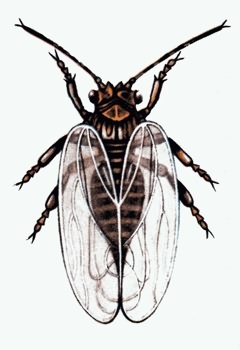Pests
Psylla pyri Linnaeus - Pear Psylla
Systematic position.
Class Insecta, order Homoptera, family Psyllidae, subfamily Psyllinae, tribe Psyllini, genus Psylla.Biological group.
It is a monophagous pest of pear-trees.Morphology and biology.
The length of adult insect reaches to 3 mm. Fore wings have brown spot near the middle of inner margin. Summer insects are yellow-brown; autumnal ones are dark-brown, almost black. There is a pattern of dark-brown stripes and spots on thorax. Scutellum of pronotum is orange, yellowish at corners. The insect has dirty-yellow antenna and hind legs, light-brown femora, dark-brown abdomen. Egg is oval, narrowing toward anterior apex, orange, with short peduncle. Flat larva is light-yellow at first, then yellow-green. Green-brown nymph has oblong shape and seven-segmented antenna. Over-wintering takes place during the phase of imago under fallen leaves, in bark cracks, and under bark scales of trees. The insects appear in March, when the average daily air temperature reaches 0°C. Coupling begins at the temperature 6°C; oviposition at the temperature 10°C. Mass oviposition takes place during the period of buds opening on pear-trees. Additional feeding is necessary for maturing of gametes. The females lay eggs in groups (2 to 17), rarely in chains (4 to 8), in cracks of bark, near bud bases, later on leaves and peduncles. The oviposition period lasts until the beginning of May. Fecundity of over-wintering female reaches 425 eggs; it lives 30-45 days. Males die after coupling. Embryonic development lasts 7-18 days. Larva hatching is observed in the second half of April (this is the period of flower buds opening). Larvae penetrate inside the bud; then they populate leaves, flowers, and ovaries. They live 11-15 days. The pests have five larval instars and five molts. Adult insects appear during blooming of pear-trees. Female lays eggs on lower side of leaves in shady part of crown. Fecundity of females of summer generation reaches 600 eggs; they live 27-32 days. The period of development of one generation is 17-48 days. Maximum population density occurs from June-July until the first frosts. The Pear Psylla populates leaves, branches, and fruits, sucking plant sap. It lives in big colonies, active in the afternoon. The Pear Psylla individuals hide in protected places under cold and cloudy weather conditions.Distribution.
The pest is known in Central and South Europe. Within the territory of the Former Soviet Union the northern border of its area reaches Kursk and Orel Regions. It causes considerable damage to pear in forest-steppe and steppe zones of Russia, in Ukraine, Moldova, Crimea, the Caucasus. The species is also found in Middle Asia. Its high harming activity occurs in the steppe zone.Ecology.
The pest wintering phase is cold-susceptible. Strong temperature drops have a bad effect on eggs. Degree days 170-190° is necessary for egg development; 230-240° for development of first generation; 520-584° for development of summer generation. The lower temperature threshold of development is 6°C; the upper one is 36°C. The most favorable conditions for insects are temperatures of 21-27°C and relative humidity of 70-80%. Abundant heavy showers considerably reduce the insect numbers. Most important predators include: Propylaea quatuordecimpunctata L., Coccinella septempunctata L., C. quinquepunctata L., Chilocorus bipustulatus L., Ch. renipustulatus L., Anatis ocellata L., Adalia bipunctata L., Adonia variegata Gz., Calvia quatuordecimguttata L., C. quinquedecimguttata F., Chrysopa carnea Steph., Chr. septempunctata Wesm., Hemerobius humulinus L., Psallus ambiguous Fall., Deraeocoris brachialis Stal., Antocoris nemorum L., Orthotylus marginalis Reut.Economic significance.
The Pear Psylla damages pear trees; sucking plant sap, it causes bad development, yellowing, twisting of leaves and peduncles, also falling of flowers, buds, and ovaries. This pest depresses tree development. Harvest decreases, fruits also become smaller. Insects secrete sweet sticky excretions. These excretions pollute leaves, plug up stomata; the leaves are covered with soot dew. Control measures include use of tobacco dust and fumigation; early spring treatment (during bud hibernation) with ovicides; later destruction of females and larvae by insecticides.Reference citations:
Alikhodzhaev D. 1954. The pear psylla. In: Bibikova A.F., ed. Proceedings of Fruit-berry Institute. N. 20. Tashkent: Fruit-berry Institute. 95-8 p. (In Russian)Chkhaidze T.A. 1970. The pear psylla - Psylla pyri L. in East Georgian conditions. In: Kanchavelli L.A., ed. Proceedings of Georgian Plant Protection Institute. N. 22. Tbilisi: Georgian Plant Protection Institute. 125-6 p. (In Russian)
Esipenko P.A. 1962. The pear psylla. Zashchita rastenii, 10: 53-4. (In Russian)
Lazarev M.A. 1968. On distribution, biology and control measures against pear psylla. In: Rubtsov N.I., ed. Proceedings of II research conference for young scientists of Crimea. Simferopol': Crimea. 84-5 p. (In Russian)
Lazarev M.A. 1979. New data on biology of pear psylla Psylla pyri L. (Homoptera, Psyllidae) in Crimea. Entomologicheskoe obozrenie, 58(1): 53-6. (In Russian)
Linnik L.I. 1973. Features of pear psylla (Psylla pyri L.) eggs distribution on tree. Vestnik zoologyi, 6: 88-9. (In Russian)
Mitrofanova M.A. 1951. On problem of species structure and biology of pear psylla damaging in the USSR. In: Duka S.Kh., ed. Proceedings of Ukraine institute of fruit-growing. N. 32. Kiev-Khar'kov: Ukraine institute of fruit-growing. 93-108 p. (In Russian)
Poddubnyi A.G. 1967. The pear psylla of Moldova. In: Yaroshenko M.F., ed. Proceedings of V conference for young scientists of Moldova. Kishinev: Shtiintsa. 24-5 p. (In Russian)
Poddubnyi A.G., Vereshchagin B.V., Lazarev V.S. 1975. Pear psylla in Moldova and control measures against it. In: Vereshchagin B.V., ed. Dendrophilous insects of Moldova. Kishinev: Shtiintsa. 62-5 p. (In Russian)
Shalamberidze N.Sh. 1973. Sun beams and development of pear psylla eggs. Zashchita rastenii, 3: 48. (In Russian)
Shalamberidze N.Sh. 1973. The results of harmful fauna revealing on fruit cultures (apple and pear trees), study on bioecology Psylla pyri L., and elaboration of its control under Imereti conditions (West Georgia). PhD Thesis. Tbilisi: State University. 32 p. (In Russian)
Simonyan G.A. 1968. Biology of pear psylla and Vasil'ev psylla under Ararat Valley conditions. Izvestia sel'skokhozyaistvennykh nauk (Erevan), 2: 47-55. (In Russian)
Tvalavadze Yu.I. 1950. Materials on pear psylla study under Georgian conditions. Proceedings of Georgian Plant Protection Institute. N. 22. Tbilisi: Georgian Plant Protection Institute. 125-6 p. (In Russian)


